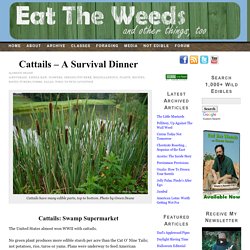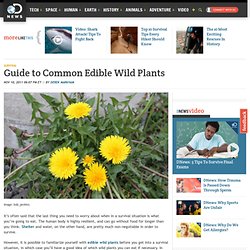

Eat The Weeds by Green Deane, the most watched forager in the world. Harvesting and Using Dandelion Roots. Cattails – A Survival Dinner. Cattails have many edible parts, top to bottom.

Photo by Green Deane Cattails: Swamp Supermarket The United States almost won WWII with cattails. No green plant produces more edible starch per acre than the Cat O’ Nine Tails; not potatoes, rice, taros or yams. Plans were underway to feed American soldiers with that starch when WWII stopped. Cattail pollen Two species of cattails are common in North America today. There is so much to know about cattails that a book could be written just about them. Flower spikes when green It is said that if a lost person has found cattails, they have four of the five things they need to survive: Water, food, shelter and a source of fuel for heat—the dry old stalks. One Boy Scout motto is “You name it and we’ll make it from cattails!”
Cattail lower stalks and C, potassium and phosphorus. The “Listronotus” grub grows larger Cattails have a surprising function and history. As mentioned earlier, cattails are the champion of starch production. Clean cattail roots. Using Weeds For Survival - Survival Life. Stinging nettles have a multitude of medicinal and edible uses and grow wild nearly everywhere in the world.

The green plants many do not consider more than weeds are actually very useful not only during an emergency situation but daily in the kitchens of folks focused on healthy eating alternatives. The primary nutritional value of stinging nettles revolves around its natural fiber and calcium content. During a disaster scenario, or when living off the grid where physical tasks are numerous, the green wonder weed edible recipes may help bolster overall health and strength.
Strong bones are never more important than when increased hours of manual labor are necessary to work a homestead — or when you can’t call a doctor. The green weed is also regarded as useful for urinary tract infections, skin treatments, seasonal allergy relief and kidney infections. Stinging Nettles Medicinal and Homesteading Uses.
Foraging Pictures, Photos, Wild Edible Plants & Mushroom Images. Eat The Weeds by Green Deane, the most watched forager in the world. Eat The Weeds by Green Deane, the most watched forager in the world. How to Find Wild Edible Plants: 15 Steps. Edit Article Edited by Robatsunbright, ClaytonB, Maluniu, Venus_Exalted and 12 others Wild edible plants are everywhere you turn.

Not only is it free food, but eating wild plants is a huge stride toward wilderness self-sufficiency. Once you know where to look and how to prepare plants you find in the wild, you'll be well prepared whether you're planning on surviving on free greens or you just want to try some new flavors next time you go camping. Be careful, though: eating the wrong plant could be fatal. Ad Steps 1Know where the best food is, depending on where you live. 15Pick the new growth off conifers in the spring. Tips Try sampling wild plants on an empty stomach with a clean palate. Warnings Don't try eating wild peas. Guide to Common Edible Wild Plants. It’s often said that the last thing you need to worry about when in a survival situation is what you’re going to eat.

The human body is highly resilient, and can go without food for longer than you think. Shelter and water, on the other hand, are pretty much non-negotiable in order to survive. However, it is possible to familiarize yourself with edible wild plants before you get into a survival situation, in which case you’ll have a good idea of which wild plants you can eat if necessary. In addition, once you learn to identify some of these common edible wild plants, you might be able to add them to your diet while you’re still in the city. READ MORE: 7 Mountaineering Knots to Use in Everyday Life Dandelions Probably the easiest plant to identify, and one of the most widespread, dandelions (pictured at top) are a great introduction to wild plant foods. Burdock The burdock plant sure doesn’t look very appetizing (especially when full of those giant prickly seedheads!)